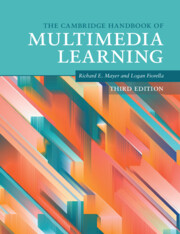Book contents
- The Cambridge Handbook of Multimedia Learning
- The Cambridge Handbook of Multimedia Learning
- Copyright page
- Contents
- Figures
- Tables
- Contributors
- Preface
- Acknowledgments
- Part I Background
- Part II Theoretical Foundations
- Part III Basic Principles of Multimedia Learning
- Part IV Principles for Reducing Extraneous Processing in Multimedia Learning
- Part V Principles for Managing Essential Processing in Multimedia Learning
- Part VI Principles Based on Social and Affective Features of Multimedia Learning
- 22 Principles Based on Social Cues in Multimedia Learning
- 23 The Embodiment Principle in Multimedia Learning
- 24 The Immersion Principle in Multimedia Learning
- 25 The Collaboration Principle in Multimedia Learning
- 26 The Animation Composition Principle in Multimedia Learning
- 27 The Emotional Design Principle in Multimedia Learning
- Part VII Principles Based on Generative Activity in Multimedia Learning
- Part VIII Multimedia Learning with Media
- Author Index
- Subject Index
- References
23 - The Embodiment Principle in Multimedia Learning
from Part VI - Principles Based on Social and Affective Features of Multimedia Learning
Published online by Cambridge University Press: 19 November 2021
- The Cambridge Handbook of Multimedia Learning
- The Cambridge Handbook of Multimedia Learning
- Copyright page
- Contents
- Figures
- Tables
- Contributors
- Preface
- Acknowledgments
- Part I Background
- Part II Theoretical Foundations
- Part III Basic Principles of Multimedia Learning
- Part IV Principles for Reducing Extraneous Processing in Multimedia Learning
- Part V Principles for Managing Essential Processing in Multimedia Learning
- Part VI Principles Based on Social and Affective Features of Multimedia Learning
- 22 Principles Based on Social Cues in Multimedia Learning
- 23 The Embodiment Principle in Multimedia Learning
- 24 The Immersion Principle in Multimedia Learning
- 25 The Collaboration Principle in Multimedia Learning
- 26 The Animation Composition Principle in Multimedia Learning
- 27 The Emotional Design Principle in Multimedia Learning
- Part VII Principles Based on Generative Activity in Multimedia Learning
- Part VIII Multimedia Learning with Media
- Author Index
- Subject Index
- References
Summary
According to the embodiment principle, students learn better when they engage in task-relevant sensorimotor experiences during learning, such as gesturing or manipulating objects. Students may benefit from enacting movements themselves and/or observing them performed by others. Embodied instruction supports learning by offloading thinking to the physical world (i.e., reduced cognitive load) and by drawing analogies between abstract concepts and meaningful actions (i.e., increased generative processing). Prior research has identified a wide range of promising embodiment methods – using gestures to represent math concepts or to trace important elements of diagrams; manipulating concrete (or virtual) objects to understand stories, math concepts, molecular structures, or physics principles; and designing visualizations that present lessons from the learner’s perspective.
- Type
- Chapter
- Information
- The Cambridge Handbook of Multimedia Learning , pp. 286 - 295Publisher: Cambridge University PressPrint publication year: 2021
References
- 5
- Cited by

